It was on January 1st, 1993, that Apple revolutionized the world of computing by unveiling the Apple Desktop Bus Mouse II as part of their esteemed Apple Mouse series. This ergonomic pointing device, characterized by its sleek design, swiftly became an indispensable accessory bundled with all-new Macintosh desktop computers. Although its production ceased on May 6th, 1998, the Apple Desktop Bus Mouse II continues to stand as a testament to its enduring impact on the technology industry.
The Apple Desktop Bus Mouse II marked a significant departure from its predecessor, introducing a more ergonomic and user-friendly shape. With its rounded curves and teardrop-like form, it captured the imagination of users worldwide. This iconic design was not only celebrated for its aesthetic appeal but also for its comfortable grip, enabling users to navigate their Macintosh and Apple II series product lines with ease.
One of the notable advancements that the Apple Desktop Bus Mouse II brought to the table was the introduction of the Apple Desktop Bus (ADB) connection method. This new input technology revolutionized the way users interacted with their Macintosh computers. The ADB allowed for a streamlined and efficient connection between peripherals and computers, setting the stage for future innovations in the realm of input devices.
Apple’s attention to detail extended beyond functionality, with the Apple Desktop Bus Mouse II available in multiple colors to complement the aesthetics of various Macintosh models. The original platinum variant was bundled with Macintosh desktop computers, while the black version was designed to harmonize with the Macintosh TV and the Macintosh Performa 5420. Additionally, a dark-gray iteration was released as a color-coded accessory for the PowerBook 100 series.
The impact of the Apple Desktop Bus Mouse II cannot be overstated. Its tear-drop shape not only won the hearts of Macintosh users during its production years but also shaped the future of mouse design. The basic form of the teardrop mouse has withstood the test of time and remains a fundamental element in current Apple mouse models. Furthermore, its influence can be seen in the designs of countless other mouse manufacturers, solidifying its status as an industry icon.
Regrettably, on May 6th, 1998, the Apple Desktop Bus Mouse II bid farewell as it was discontinued and succeeded by the Apple USB Mouse. While its discontinuation marked the end of an era, it opened the door for further innovations in input device technology. The Apple USB Mouse, with its advanced connectivity and enhanced functionality, paved the way for future iterations and inspired a new generation of mouse designs.
As we commemorate 31 years since the release of the Apple Desktop Bus Mouse II, we celebrate its enduring legacy and the impact it had on the technology industry. From its ergonomic design to the introduction of the Apple Desktop Bus, this iconic mouse left an indelible mark on the world of computing. Its timeless design language continues to influence mouse design to this day, reminding us of the profound impact that Apple’s innovations have on shaping our digital experiences.

Apple Desktop Bus Mouse II Details
| Introduced | January 1, 1993 |
| Discontinued | May 6, 1998 |
| Model Number | M2706 M2707 |
| Price | Unknown |
| Colors | Platinum Black Gray |
| Weight | 0.29 Ibs. 131.54 Grams |
| Dimensions | 1.3″ H x 2.4″ W x 4.2″ D 33.02 mm H x 60.96 mm W x 106.68 mm D |
System Requirements
- Macintosh with ADB port
Mouse Specs
| Tracking | Mechanical |
| Buttons | 1 |
Connections
| Connection | ADB |
Further Reading and References
- Apple pointing devices – Wikipedia
- Steve Wozniak autographed Apple Desktop Bus Mouse #2 – Signed by Woz
- Apple Desktop Bus Mouse II (ADB) – Apple Rescue of Denver
Disclaimer: The data presented in this article is under continuous development and has been manually collected from various sources based on their availability. The author of this article may revise this dataset as additional research is conducted and reviewed. Please note that the information is provided “as is” and “as available” without express or implied warranties. The author cannot be held responsible for any omissions, inaccuracies, or errors in the published information. Any warranties relating to this information are hereby disclaimed.
Last updated: June 27, 2023
